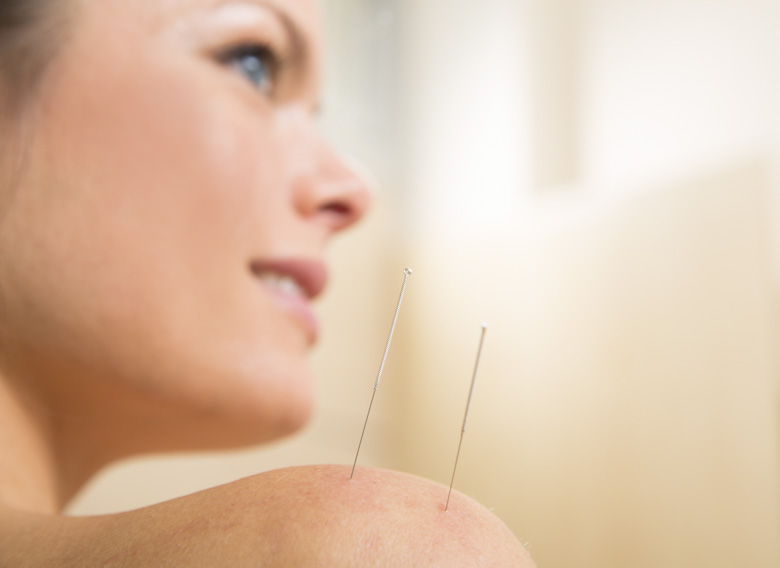Acupuncture is an effective treatment modality for breast cancer related lymphedema (BCRL). Nanjing University of Traditional Chinese Medicine researchers investigated the effects of acupuncture on BCRL patients in a randomized controlled clinical trial. The study finds that acupuncture effectively reduces upper arm circumference, improves shoulder range of motion, and patients self-reported overall quality of life improvements.
Lymphedema occurs when excess lymph (a fluid that circulates throughout the body that removes bacteria, wastes, etc.) accumulates in specific areas. BCRL is a potential side effect of breast cancer surgery and often occurs in the upper arms. Breast cancer surgical procedures often involve a lymph node biopsy or removal of lymph nodes from the underarm area. Surgery and radiation therapy may damage vessels and prevent lymph circulation thereby causing fluid to accumulate in tissues.
BCRL includes arm swelling or stiffness, and skin thickening or roughness. Many breast cancer survivors develop BCRL and current treatment methods are limited, with the treatment mainly involving physical therapy, compression sleeves, and manual and mechanical lymph drainage. In both Traditional Chinese Medicine (TCM) and Traditional Korean Medicine (TKM), BCRL is classified as edema and is considered a result of qi and blood stagnation combined with deficiency.
The research of Yao et al. was conducted at the Affiliated Hospital of Nanjing University of Traditional Chinese Medicine. Thirty breast cancer survivors meeting stringent inclusion criteria were randomly separated into experimental and control groups. The experimental group received acupuncture treatment for 30 minutes every other day for 30 consecutive days. The acupuncture points used in the investigation were the following:
LI10 (Shousanli)
LI11 (Quchi)
LI14 (Binao)
LI15 (Jianyu)
TB5 (Waiguan)
TB14 (Jianliao)
Notably, the acupuncture points are located locally to the areas where the lymphedema is present. Additionally, warm needle acupuncture treatment was applied to TB5, LI15, and TB14. At needle handles, 3cm moxa pieces were burned to provide heat through the needle shaft. The control group received 900mg of diosmin (a bioflavonoid complex), three times a day, for 30 days. The results of the treatments were measured using 4 factors:
index of effectiveness calculated using arm circumferences
shoulder range of motion (measuring angular changes at 6 directions of movement (anteflexion, rear protraction, adduction, abduction, intorsion, extorsion)
self-reported quality of life
clinical safety and adverse events
At the end of the 30 day treatment regimen, the researchers note that "the overall effective index reached 51.46% in the experimental (acupuncture) group and 26.27% in the control group (p < 0.00001)." Another set of measurements referenced specific regions of the body. The researchers note, "the effective index in the experimental (acupuncture) group increased to 65.67% at the wrist and to 44.71% at 10 cm above the elbow, which was significantly higher than in the control group, where those indexes had increased to 34.17% and 17.30% respectively (p < 0.05)."
Shoulder range of motion improved significantly in all 6 directions measured in the acupuncture treatment group. Self-reported quality of life scores were significantly better for the acupuncture group than the control group. There were no reported adverse effects during treatment and all clinical safety exams were within normal ranges. The researchers conclude, "Compared with diosmin, warm acupuncture treatment can effectively reduce the degree of BCRL at the specific acupoints treated and can promote quality of life. Warm acupuncture showed good clinical safety, without any adverse effects on blood or the cardiovascular system."

In an independent investigation, Cassileth et al. find acupuncture effective for the treatment of breast cancer related lymphedema. Cassileth et al. note that a "mean reduction in arm circumference difference of 0.9cm (95% CI, 0.72-1.07cm; p < .0005)," with 33% of the patients showing a reduction of more than 30% in arm circumference. In the study, 33 patients with BCRL (duration of illness ranging 0.5–5 years) received acupuncture treatments twice a week for four weeks. Treatment duration was 30 minutes per acupuncture session. Filiform acupuncture needles were inserted to a depth of 5–10mm. The acupoints selected are listed below:
TB14 (Jianliao)
LI15 (Jianyu)
LU5 (Chize)
CV12 (Zhongguan)
CV3 (Zhongji)
LI4 (Hegu)
ST36 (Zusanli)
SP6 (Sanyinjiao)
A similar study was conducted at the Daegu Catholic University Medical Center in Daegu (Korea) and suggests that acupuncture alleviates BCRL symptoms and improves the quality of life. Saam acupuncuture was used 3 times per week (30 minute sessions) for 6 consecutive weeks on nine BCRL patients. "Saam acupuncture treats illness by tracing the fundamental cause of the disease. It follows the Yin-Yang theory and the Five Element theory, and Saam’s principles involve supplementing deficiency and draining excess." Consistent with traditional acupuncture theory, Saam acupuncture selects standard acupoints based on diagnostics. The researchers note, "The basic strategy of treating illness with Saam acupuncture is to harmonize these interruptions manifested by Stagnation and irregularities, or imbalances caused by Deficiency and Excess."
The needles were inserted 5–20mm into the skin and then manipulated gently to obtain deqi. Acupuncture points were selected dependent upon traditional Chinese medicine pattern differentiation (e.g., deficiency, excess, cold, heat). The following are examples of acupoints selected for use in the study:
SP2 (Dadu)
LU10 (Yuji)
BL60 (Kunlun)
GB38 (Yangfu)
SI5 (Yanggu)
ST41 (Jiexi)
LI5 (Yangxi)
The results of the investigation quantified a significant reduction in the average circumferences of the upper arms, elbow, and forearms. Using a visual analogue scale (VAS), there were significant reductions in stages of lymphedema and improvements were noted in the self-reported quality of life scores and reports.
References
C. Yao, Y. Xu, L. Chen, et al (2016). Effects of warm acupuncture on breast cancer-related chronic lymphedema: a randomized controlled trial. Curr Oncol. 2016 Feb; 23(1): e27-e34.
Young Ju Jeong, Hyo Jung Kwon, et al (2015). Treatment of Lymphedema with Saam Acupuncture in Patients with Breast Cancer: A Pilot Study. Med Acupunct. 2015 Jun 1; 27(3): 206-215.
Barrie R. Cassileth, Kimberly J. Van Zee, et al (2013). Acupuncture in the treatment of upper-limb lymphedema. Cancer, 119: 2455–2461.

![Diseases, Symptoms, tcm, [tcmwindow.com]](/uploadFile/adImg/2015/11/11/f5cbfcc0-4df5-4646-9b9a-f316651a0199.jpg)





